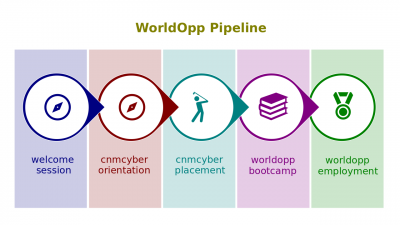Difference between revisions of "Workplace Conditions"
(→Script) |
(→Script) |
||
| Line 11: | Line 11: | ||
===Script=== | ===Script=== | ||
| − | :[[Working condition]]s refer to health and safety standards, workplace rules, and other workplace [[requirement]]s. Some of these conditions are imposed by [[labor law]] | + | :[[Working condition]]s refer to health and safety standards, workplace rules, and other workplace [[requirement]]s. Some of these conditions are imposed by [[labor law]]. Other regulations outside of the [[employer]], for instance . Some are imposed by the [[employer]] and, what is very common, by managers and administrators, both direct and indirect, within the employing organization. |
Revision as of 19:04, 6 May 2020
Working Conditions (hereinafter, the Lectio) is the second lesson part of the Nature of Work lesson that introduces its participants to work characteristics and related topics.
This lesson belongs to the Introduction to Employment session of the CNM Cyber Orientation. The Orientation is the second stage of the WorldOpp Pipeline.
Contents
Content
The predecessor lectio is Task Attributes.
Key terms
- Working condition. The particular state that a worker is in.
Script
- Working conditions refer to health and safety standards, workplace rules, and other workplace requirements. Some of these conditions are imposed by labor law. Other regulations outside of the employer, for instance . Some are imposed by the employer and, what is very common, by managers and administrators, both direct and indirect, within the employing organization.
Health and safety standards: Federal law requires employers to provide a safe working environment and to provide workers with protection against hazards, such as eye protection, gloves and decontamination facilities.
Workplace rules: Many states have laws that restrict work hours or require employers to provide paid breaks to employees.
Failure to comply with workplace condition laws and regulations can result in fines, lawsuits from injured or disgruntled employees and bad publicity. Understanding your responsibilities, and exceeding them, can protect your business against legal trouble.
Consequence of error is the degree to which the result of an error is serious. Some of those errors cannot be readily correctable; they are attributes of some professions such as a surgeon or, no doubts, sapper. Some of those errors are both preventable and correctable, but human factors interfere both prevention and mitigation.
- For example, the Dirty Dozen of Human Factors is the twelve most common maintenance-related human factors that are responsible for the majority of incidents and accidents in aviation. Industries like nuclear power and aviation practice special training for workers to deal not only with own errors, but also the ones of worker's supervisor.
- The COVID-19 pandemic demanded physical distancing, work virtualization, and other requirements.
- Particular supervisors, employers, or industries tend to add specific work demands to employee workloads.
Work-Seller Competence is the successor lectio.
